Stock trading vs options trading, what should you trade? What is better? Is it better to trade stocks or is it better to trade options, asks Markus Heitkoetter of Rockwell Trading.
That’s what we’re going to talk about today. I will also show you practical examples from trades that occurred recently, so let me jump on to the desktop.
Now, I want to use an account size of $20,000 as an example here where I’m comparing whether it is better to trade stocks vs. options. Depending on your account size, just multiply the numbers that I’m showing you by whatever your account size is, and you’ll get the idea.
The idea is, on a $20,000 account, we want to risk 2% of the account. This would be $400, nothing more.
Comparing Stock Trading vs Options Trading
Now, as we are comparing stocks and options, here are the things that I want to compare. First of all, I want to write down how much we are risking stock trading vs. options trading. I also want to write down the reward, how much are we planning to make on the stock or the option.
Based on this, I want to write down the risk/reward ratio, and also very, very important, the buying power. What is the buying power? The buying power is the amount of your account that you need to reserve for this trade. It is not the risk and you’ll see this in just a moment.
Let’s take a look at some very specific trades that just happened.
INSW Stock Trading vs. Option Trading
The first trade that I want to discuss is International Seaways (INSW). On the PowerX Optimizer, INSW came up as a trade, as a buy to open. And the idea here is that we are buying 239 shares based on a $20,000 account at $22.84.
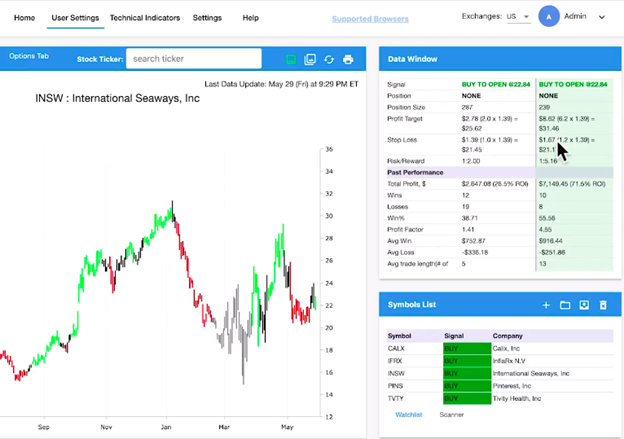
Our stop loss here is $1.67 and we are trading 239 shares. I want to keep it a little bit easier for all of us with the math so we’re trading 240 shares. What is our risk? Per one share, we are risking $1.67, and we are trading 240 shares, meaning that our risk is exactly $400.80. So here let’s just round it to $401.
Now, what is the potential reward that we are looking for? Here we are looking for a reward of $8.62 per share. $8.62 times 240 shares, so we’re looking to make $2,069.
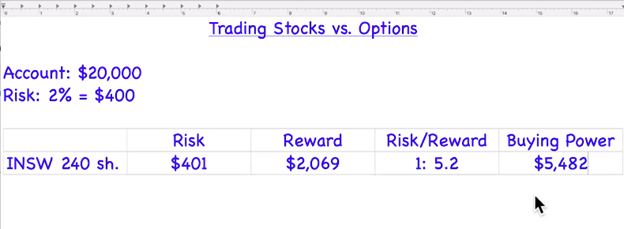
We’re putting this into our table, $2,069. The risk/reward ratio here, PowerX Optimizer is calculating it, it’s 1:5.16 so let’s just say 1:5.2. Now for the buying power. Again, we are buying 240 shares, and the cost per one share is $22.84, so we need $5,482 in buying power. This is how much our buying power will be reduced when we enter the trade.
Now, let me ask you, is this making sense thus far? Just so that you know what happens when you’re trading the stock? And again, we are trying to risk around 2% of the account here, $401.
Now, let’s take a look at the option here. I prefer to trade the in the money, I’ll do another article on the difference between ITM and ATM.
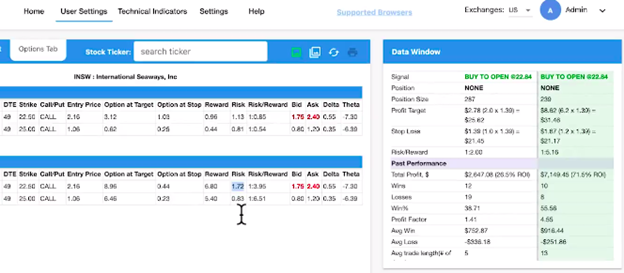
But here we are talking about the $22.50 call, and you see that the risk is $172 per one option. If we want to risk $400 overall, we’re dividing this by 172 and we can trade 2 options risking $344.
We’re risking a little bit less and this is just based on the price of the option.
In terms of the reward, we’re looking to make $6.80, it’s $680 per one option and we are trading 2 options, meaning that if this trade works out, we are making at least $1,360.
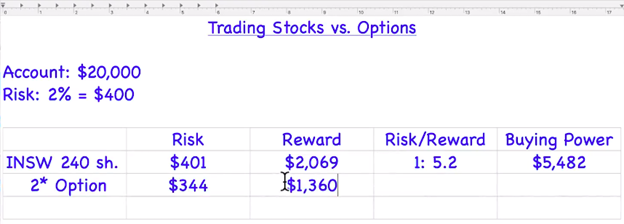
Now, as you can see, we are making a little bit less. Let’s take a look at the risk/reward, which PowerX Optimizer is calculating for us.
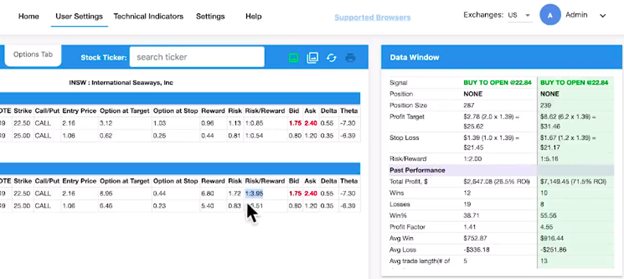
The risk/reward is slightly lower, it’s 1:3.95. Now we’re rounding it up so it’s 1:4.0. As you can see, the risk/reward ratio when trading the option is slightly worse but here’s the deal.
What is the buying power that we need for this? The buying power that the broker will deduct from the overall buying power in the account is our entry price.
So here we are trying to enter at $2.16, we can round it up to $2.20, and since we are trading 2 options this means that our buying power is $440. Can you already see what the difference is between stock trading vs options trading here? Your buying power is less than 10%.
Now, keep in mind, the buying power is not what you’re risking. The buying power is just how much of your $20,000 is being held in reserve for this particular trade. You can’t use this money anymore.
If you trade the stock, you will still have around $14,500 left. However, if you’re trading the option, you still have $19,500 left. Is this making sense thus far?
TVTY Stock Trading vs Option Trading
The other trade that I want to show you is Tivity Health (TVTY). Here we wanted to trade 392 shares, so let’s just round it up to 400. Now let’s discuss the risk first.
The risk is $1.02 per one share. We’re taking $1.02 times 400 shares, meaning that we would risk $408, which is still within our parameters. We were planning to risk around $400 so here it would be a little bit more, it would be $408.
Now, if this trade works out, here is what the reward would be. The reward is $5.61, that’s how much we are trying to make on this trade. And if we take the $5.62 times 400 shares, we are trying to make $2,248. The risk/reward, if we look at this, is 1:5.5.
Now, here is the buying power that we need. TVTY is trading at $11.30, so this is where again, $11.30 times 400 shares, we need $4,520 in buying power.
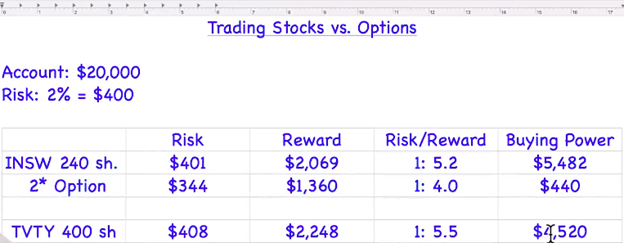
Again, not a big deal if you’re trading a $20,000 account, it will be reduced and you’ll have less money to trade right now, around $15,500. Very, very, very important, this is not the risk. This here is the buying power that is needed. Our risk is $408.
Now let’s take a look at the options tab. Our risk here per one option is $141. If we want to risk $400 overall, we’re dividing it by $141, it’s 2.83.
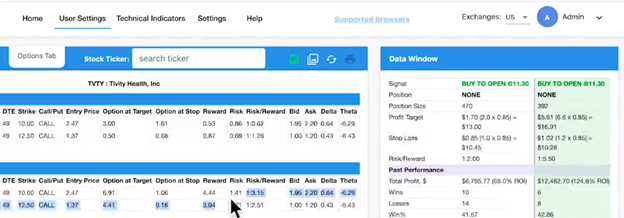
Now, in order to make it all a bit easier to compare apples with apples here, I am actually saying that we would trade 3 options, and $141 is what we are risking per one option, so $141 times 3.
It’s a little bit more than our $400, but I think we are still OK here. We would risk $423. Now the potential reward per one option is $444. This is where we take $444 times 3, and again, this is where we are looking at $1,333.
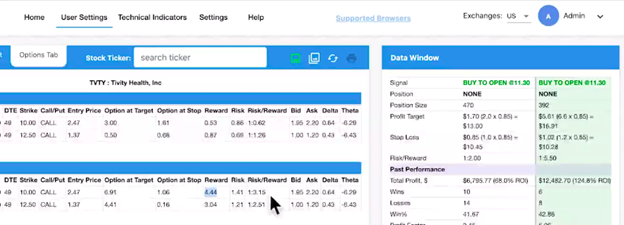
As you can see, the risk/reward ratio here is worse than if we would trade the stock. It is 1:3.15 so we are rounding it again to 1:3.2. Again, it would be better to trade the stock, but you’re using quite a lot of your buying power. For the option, all you need, all that is reduced, is your entry price, and the entry price it’s $2.47. Let’s say $2.50 times 3 is $750.
As you can see you need less buying power, but you also have a smaller reward. But this is why I say usually on a smaller account, it makes sense to trade options instead of stocks.
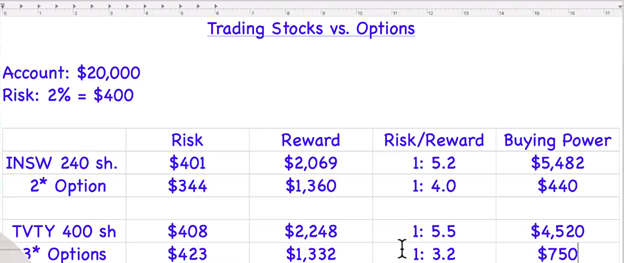
Now the other important thing, especially when you trade a retirement account, is that you don’t get a margin account. This means that you cannot leverage the money that you have in the account and you cannot short stocks.
In the US, in a retirement account, you cannot short stocks. However, what you can do in a retirement account is that you can trade put options, and with put options, you can bet on a falling market.
This brings me back to the question…
What is better, stock trading vs. options trading?
Well, this is why I wanted to show you a direct comparison using a real-life example. This way you see exactly when it is more advantageous to trade stocks, and when it is more advantageous to trade options.
Long story short, often for smaller accounts, since you use less buying power, it makes more sense to trade options. And now you have a direct comparison between stock trading vs. options trading that will hopefully help you decide what is best for you.
Learn more about Markus Heitkoetter at Rockwell Trading.





















